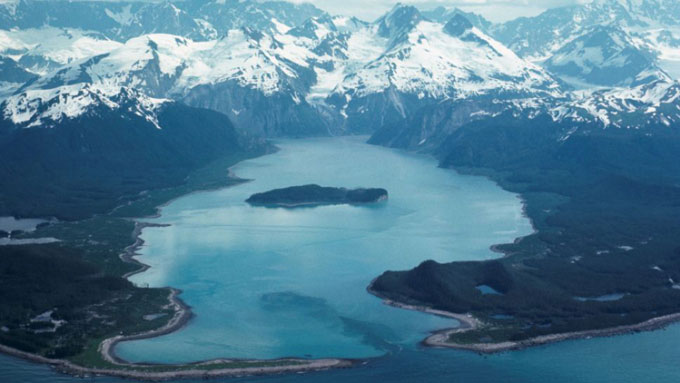The highest 524m super tsunami ever recorded on Earth
A tsunami taller than the Empire State Building occurred in 1958, after a landslide in Lituya Bay.

Lituya Bay seen from above.
In July 1958, a magnitude 8.3 earthquake in the Fairweather Fault shook the southern coast of Alaska. This event led to a massive landslide in Lituya Bay, causing a devastating tsunami that swept through the narrow water and killed five people.
The huge wave flattened trees on the slopes surrounding the bay with a maximum height of 524 m above sea level - higher than the Empire State Building in New York (443 m). This is called the runup height - the height reached by the wave after making landfall.
"This is the largest wave ever recorded and witnessed by eyewitnesses," said Hermann Fritz, a professor of civil and environmental engineering at the Georgia Institute of Technology who specializes in tsunamis and hurricanes. There are likely to be larger waves in Earth's history, he added. This can be inferred from geological deposits, but they are still not well understood.
Fritz is the lead author of a study published in the journal Pure and Applied Geophysics in 2009. This study reproduced the tsunami in Lituya Bay using a dedicated laboratory tank with a 1:675 simulation shape of the bay.
The researchers estimate that, with the tsunami reaching this height, the initial landslide could have dumped about 30 million cubic meters of rock into Lituya Bay. The violent landslide provided the force to create the record-breaking wave, but the shape of the bay is the real reason the waves are so high, according to Fritz.
Research in the journal Natural Hazards and Earth System Sciences in 2019 created a simulation of the Lituya Bay tsunami using a computer model. Video: José Manuel González-Vida and associates
Lituya is a fjord - a long and narrow coastal inlet with steep slopes created by an ancient glacier. The bay is about 14.5 km long with the widest point being 3.2 km. This area has a maximum depth of 220 m and is connected to the Gulf of Alaska by a gap of 300 m wide. The landslide that caused the tsunami in 1958 occurred in Gilbert cove at the far end of the fjord, farthest from the sea.
During a typical landslide tsunami, the waves will radiate out in a fan pattern. But the narrow shape and steep slope of Lituya Bay, plus the starting position, caused the full force of the waves to pool in one direction. Since there was nowhere else to go, the water was pushed up the surrounding high mountain slopes. That's why the 1958 tsunami reached such a high runup height, Fritz said.
This type of powerful wave is called a megatsunami. Tsunami tsunamis caused by landslides are much rarer than tectonic tsunamis caused by seafloor faults as tectonic plates move (e.g. the 2011 tsunami in Japan), accounting for more than 90% of the total, Fritz said. tsunami number.
Landslide tsunamis are much shorter-lived than tectonic tsunamis. "A landslide tsunami can be very large near the source but disintegrate quickly," Fritz said. Meanwhile, tectonic tsunamis start out as small waves, then travel great distances and increase in height as they reach the shore. During the 1958 Lituya Bay event, the waves dropped to less than 100 m high when they reached the cleft and did not spread further into the Gulf of Alaska.
This is not the first tsunami of its kind to hit Lituya Bay. Geologists have found traces of smaller tsunamis in 1853, 1854 and 1936, but evidence of them was washed away by the super-tsunami, according to the Western States Seismological Policy Council (WSPC).
Some people survived the record-breaking tsunami despite being on boats in the bay when the landslide struck. They either overcame the wave or escaped through the mouth of the bay, the WSSPC said. About three weeks after the waves dissipated, Lituya Bay was deemed safe enough for researchers to survey. Researchers at the time described as many as millions of trees uprooted and floating in the bay.
- Discovered 'tsunami super waves' coming down from ... the universe
- Evidence of collapsing volcanoes that cause the greatest tsunami in history
- Super 50m tsunami can sweep Mars
- Maybe the 'Sun Tsunami' will encounter the globe
- Photo reporter miraculously survived the tsunami
- 'Thousands of people' tsunami hit Europe anytime
- Tsunami of nearly 100m each swept the Earth
- Super typhoon from earth attack in 2012
- Photo: Manually watch the biggest moon in 20 years
- The 10 biggest storms recorded in history
- Human skull asteroids can create super terrible tsunamis
- Decipher the mysterious tsunami in the East Sea
 The most famous scientific failures in history
The most famous scientific failures in history Mysterious genius mechanic and the machine froze time
Mysterious genius mechanic and the machine froze time The son carries the 'bad gene' of genius Albert Einstein
The son carries the 'bad gene' of genius Albert Einstein Isaac Newton
Isaac Newton